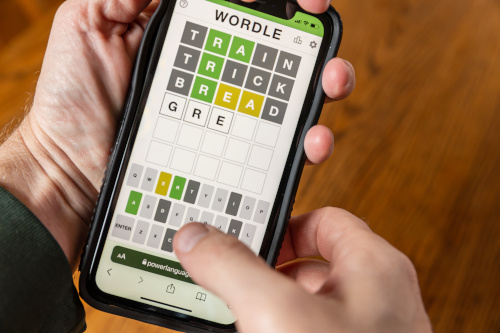“Did you get the Wordle today?” What initially began as something Josh Wardle created to serve as a personal daily game has become a household name, with users sharing their Wordle progress on social platforms and urging friends to start playing. And now, teachers are using Wordle, along with other games with viral status, to boost student engagement.
The popular game tasks users with guessing–in six guesses–a five-letter word. When users guess a word, a green square indicates they have guessed a correct letter in its correct spot. A yellow square indicates that the letter is in the word, but the user has put it in the wrong spot. And a gray square indicates that the letter is not in the word.
In a January tweet, teacher Samantha Morra shared how teachers can create their own custom Wordle words of any length–a great way to add longer and more challenging vocabulary or other relevant words and concepts to a lesson.
College professor Michael Spencer explored the way game design and user experience can encourage good teaching practice–namely, that making mistakes is OK, and that students learn as much from their mistakes as they can their successes.
Some educators have suggested using Wordle with younger students to teach them how to navigate and develop keyboarding skills.
Wordle has also invoked passionate debates and lengthy social media discussions among statistics enthusiasts, who argue over the best “first word” to use. Different strategies often enter these conversations–is it better to use all your guesses to guess the correct word, or should you use one (or more) guesses to eliminate letters, purposely not using any letters you know to be in the correct word?
Teachers are getting creative, too–putting students in pairs if devices are limited, laminating large pieces of paper with six rows of five empty squares and using colored dry-erase markers to record classroom guesses, and more.
If you’ve heard of Wordle, you’ve likely heard of nerdle. Nerdle relies on the same color-coded square concept as Wordle, but nerdle players are trying to guess a mathematical calculation.
Created by Richard Mann and his children, more than 1 million people were playing the game within three weeks of its launch, and 70 percent of players are in the U.S.
Many of those users are teachers who are using nerdle in classrooms as morning warm-ups or ways to reinforce newly-taught concepts. As a bonus, the game has great potential to increase student engagement in harder-to-teach classes.
“We have nerdle fever! We now can’t go a day without a nerdle,” said Cyndi Stevens, a grade school mathematics teacher in Reading, PA. “We love collaborating with others, stretching our brains, and sharpening our number sense and problem solving skills. These 4th grade mathematicians are showing positive mathitudes! Our marvelous mathematicians used nerdle to challenge ourselves during Morning Meeting. They did an amazing job…solved the math puzzle on 3rd try!”
“Watching nerdle’s amazing viral growth in the weeks after we launched it back in January was amazing… But as well as the excitement with the sheer number of players, we quickly heard that some teachers had started using nerdle in math lessons. That’s when we realized we could really do something positive with our little game,” Mann said. “Early on, we had some teachers saying, ‘Love the game, but we think we could have some younger kids playing it at school if you could make it a little bit easier,’ which is why we launched both mini nerdle, the first variant, and pro nerdle, where anyone can create their own nerdle challenge.”
Hearing from teachers like Stevens shows Mann that what he and his children created really has an impact.
“But the real highlight of my week? A teacher posting a photo or video showing the whole class playing a game of nerdle, with a big screen up at the front and the whole class cheering when they manage to solve the daily nerdle challenge.”
- 4 ways to support work-based learning - April 23, 2024
- Prioritizing inclusivity in game-based learning - April 22, 2024
- Friday 5: Universal Design for Learning - April 19, 2024

